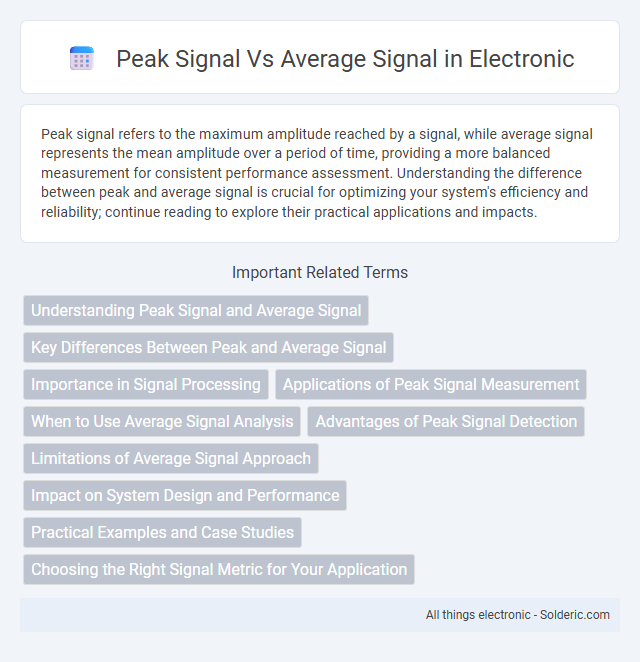Peak signal refers to the maximum amplitude reached by a signal, while average signal represents the mean amplitude over a period of time, providing a more balanced measurement for consistent performance assessment. Understanding the difference between peak and average signal is crucial for optimizing your system's efficiency and reliability; continue reading to explore their practical applications and impacts.
Comparison Table
| Criterion | Peak Signal | Average Signal |
|---|---|---|
| Definition | Maximum instantaneous signal amplitude | Mean signal amplitude over a period |
| Measurement | Highest value in a signal sample | Sum of values divided by number of samples |
| Use Case | Detecting transients, spikes, and overloads | Evaluating overall signal power or level |
| Signal Representation | Single-point maximum value | Continuous average value |
| Importance in Signal Processing | Important for dynamic range and clipping prevention | Important for noise analysis and signal stability |
| Example Metric | Peak-to-Peak Voltage | Root Mean Square (RMS) Voltage |
Understanding Peak Signal and Average Signal
Peak signal represents the maximum amplitude of a waveform or data set at any given moment, while average signal measures the mean value over a period of time or set of samples. Understanding the difference is crucial for accurate signal processing and analysis, as peak values indicate maximum capacity or stress points, whereas average values provide a general sense of performance or energy levels. Your analysis can be refined by considering both metrics to capture the full dynamics of signal behavior.
Key Differences Between Peak and Average Signal
Peak signal represents the maximum instantaneous amplitude of a waveform, indicating the highest point reached by the signal. Average signal refers to the mean value of the signal over a specified time period, often providing a more stable measurement of signal strength. Understanding the key differences is essential for applications in audio processing, communications, and signal analysis where peak values affect clipping and distortion, while average values influence perceived loudness and power consumption.
Importance in Signal Processing
Peak signal magnitude represents the highest instantaneous value in a waveform, critical for avoiding distortion and ensuring system components handle maximum load safely. Average signal value reflects the mean power or energy over time, essential for efficient power allocation and noise reduction in communication systems. Balancing peak and average signals optimizes dynamic range and signal integrity, improving overall performance in digital and analog processing applications.
Applications of Peak Signal Measurement
Peak signal measurement is crucial in applications requiring accurate detection of transient events, such as audio engineering, telecommunications, and radar systems. It enables precise analysis of signal distortions, ensuring your equipment operates within safe limits and maintains high-quality performance. Monitoring peak signals helps prevent damage from overloads and optimizes system response in dynamic environments.
When to Use Average Signal Analysis
Average signal analysis is essential when evaluating consistent, long-term performance in communication systems, as it provides a realistic measure of the overall signal strength over time. It is particularly useful in applications such as wireless network optimization and audio processing, where understanding the mean signal level helps ensure stable operation and quality. Average signal metrics effectively account for fluctuations and noise, offering a reliable basis for adaptive adjustments and error correction.
Advantages of Peak Signal Detection
Peak signal detection offers enhanced sensitivity by capturing the highest signal intensity, which is crucial for accurate identification of transient or low-abundance events in various applications such as medical imaging and communications. This method improves signal-to-noise ratio by focusing on maximum signal amplitude, enabling more precise measurement compared to average signal detection. The ability to detect rapid signal fluctuations makes peak detection indispensable for real-time monitoring and early anomaly detection in systems like radar and sensor networks.
Limitations of Average Signal Approach
The average signal approach often masks important variations by smoothing out peak values, leading to inaccurate representation of signal strength or quality. This method can fail to capture transient spikes or critical high-intensity moments that affect overall system performance. For your analysis, relying solely on average signals may overlook essential data peaks necessary for precise diagnostics and optimization.
Impact on System Design and Performance
Peak signal levels influence the sizing of system components such as amplifiers and analog-to-digital converters, requiring them to handle short-duration maximum amplitudes without distortion. Average signal levels determine power consumption and thermal management, affecting component reliability and energy efficiency over sustained operation. Balancing peak and average signal considerations is essential for optimizing both performance and cost-effectiveness in communication and signal processing systems.
Practical Examples and Case Studies
Peak signal strength often reveals transient performance capabilities in wireless communication, such as a Wi-Fi router achieving 100 Mbps during short bursts in a busy office environment. Average signal strength provides a more consistent measure of typical network reliability, demonstrated in case studies where rural broadband services maintain 30 Mbps to ensure stable video streaming. Practical examples highlight how comparing peak and average signals aids in optimizing network designs for both high-demand events and everyday usage scenarios.
Choosing the Right Signal Metric for Your Application
Choosing between peak signal and average signal metrics depends on the application's tolerance for signal fluctuations and the importance of transient spikes. Peak signal measurement is crucial for systems that must handle maximum instantaneous values, such as audio equipment or communication systems prone to brief surges. Average signal metrics provide insights into long-term performance and energy consumption, making them ideal for applications focused on steady-state behavior and overall efficiency.
Peak signal vs average signal Infographic

 solderic.com
solderic.com